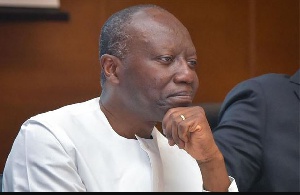Rating agency, Standards and Poor's (S&P) Global has maintained its 'B/B' long- and short-term foreign and local sovereign credit ratings on Ghana following pressure on public finances, with interest payments representing over 30% of government revenues.
S&P Global also assigned a stable outlook in a statement issued on Friday, 15 March 2019 due to what it described as fairly strong growth prospects.
This comes in the wake of government eyeing a US$3 billion Eurobond, in the coming weeks, as a stopgap measure for the weakening Ghana Cedi which strengthened by 0.2 percent within the week to 5.6452 per the US Dollar, the first weekly gain since 15 February 2019.
However, S&P Global, said they could consider lowering the rating “if we saw a risk of material deterioration in monetary policy credibility, or if external pressures mounted due to, for example, stronger depreciation of the Ghanaian cedi and higher inflation, which might result in significant outflows of nonresident capital beyond our expectations”.
On the other hand, the rating agency stated that they “could consider raising our ratings if Ghana implements and adheres to measures that materially alleviate pressure on public finances beyond our expectations without weakening government's capacity to maintain balanced economic growth”.
S&P further projected that budget deficits will average 4.2% of Gross Domestic Product (GDP) in 2019-2022. The firm pointed out that revenue underperformance will remain a concern, and the implementation of flagship projects alongside other expenditures in the run-up to the 2020 elections could spur higher spending.
“Owing largely to the depreciation of the cedi, we forecast that general government debt will increase on average by 6.8% of GDP per year over 2019-2022. We estimate Ghana's government debt position (net of liquid assets) will remain somewhat high, but stable at about 55% of GDP over the forecast period to 2022. Furthermore, state-owned enterprises, particularly in the energy sector, have a sizable debt stock that we believe could pose a contingent liability to the government.
“Although current account deficits are likely to remain below 4.2% of GDP, external funding needs are relatively high, and we see risks regarding investor sentiment; for example, nonresident investment in the government's local currency debt is currently declining. Material outflows of nonresident capital would aggravate external funding pressure and fiscal financing options,” the statement added.
Click to view details



Business News of Saturday, 16 March 2019
Source: classfmonline.com

















